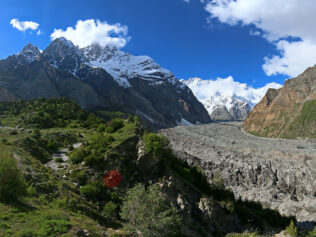
Earth undergoes a constant metamorphosis. Tectonic plates are moving. Lava is congealing. Mountains are being uplifted. Living organisms influence the composition of the atmosphere, causing rocks to crumble. On top of that, Homo sapiens – supposedly so wise – remains unaware of the damage he inflicts upon himself.
Nobody had a clue why James Hutton, after obtaining his Doctor of Medicine degree, decided to work the land. He definitely didn’t move to the countryside for financial reasons: he hadn’t needed to worry about money ever since he invented a new and easy method of producing sal ammoniac. His friends suspected he never actually wanted to be a physician and studied medicine only to continue chemistry research. Apparently, he often ridiculed medical practices, which is understandable given that in the 18th century they were mostly ineffective and based on presuppositions and rituals rather than experiential knowledge.
Anyway, when around 1750 Hutton inherited land in his native Scotland, he committed himself to overseeing it and introducing innovative solutions, which proved significant for agricultural development. What contributed to advancements in geology, on the other hand, was the fact that he owned two farms, each on a different type of land. Those dissimilarities intrigued the would-be doctor, for whom nothing seemed as appealing as facts and observations. In a 1753 letter, he wrote that he had “become very fond of studying the surface of the earth, and was looking with anxious curiosity into every pit or ditch or bed of a river that fell in his way.” In those caves, holes, morasses and streams he was able to see the future of our planet.
Congealing, uplifting…
Hutton’s contemporaries who still did science under the influence of the Bible, claimed that the surface of the Earth was shaped by the great flood. It was a catastrophe-driven theory, in which one single event was supposed to instantly shape the landform, which would later remain unchanged. Hutton opposed this theory, putting forward the idea of uniformitarianism, according to which geological processes that acted in the past must still be acting in the present. His idea had been crystallizing for 10 years before he embarked on a scientific expedition in search of evidence. He didn’t need to travel far, though. He found what he was looking for at the nearby Siccar Point.
Hutton discovered there an example of what he called “unconformity”: dark grey vertical rocks (greywacke) underneath and horizontal red rocks (mudstone) on the top. He concluded that such a junction of rocks could have been formed only by the powerful forces of nature operating over a long time. The underlying greywacke was deposited beneath the ocean’s surface. It was changed by uplift, folding and erosion, and then again brought into the deep waters, where the layers of mudstone would slowly build up on it over time.
In his masterpiece, The Theory of the Earth, Hutton relies heavily on metaphors. He refers to nature as a Mother, Book, Machine, Fabric and Great Flux. He also talks about Microcosm and Macrocosm, drawing an analogy between nature as a whole and an individual organism. As Stephen Norwick, a Hutton scholar, notes, all these metaphors are dynamic. In Hutton’s theory, the Earth is always in a process of change, never stable and fixed. This was an absolutely revolutionary idea back then. For Hutton, the history of the Earth was a history of slow and ongoing rock formation, lava congealing, and mountain uplifting.
He also emphasized how the animate and the inanimate worlds intersect. When he found fossils in sedimentary rocks, he considered it proof that the living organisms that inhabit the Earth also shape it. Shortly after Hutton’s death, their impact took an unprecedented form: fossils were being brought up to the Earth’s surface by a species called Homo sapiens, who would excavate and burn them on a massive scale. The Industrial Revolution and the exploitation of fossil fuels opened a new chapter in the history of humankind and the Earth. It took a long time, however, before Homo sapiens understood the ramifications of these actions.
The power of life, the power of mind
The Austrian geologist Eduard Suess noted that “[t]he plant, whose deep roots plunge into the soil to feed, and which at the same time rises into air to breathe, is a good illustration of organic life,” thus introducing the concept of biosphere. In 1911, the young Russian-Ukrainian scholar Vladimir Vernadsky had a chance to meet Suess, who shared with him his observations. However, while in Suess’s theory the biosphere emerges as a subtle addition to gaseous atmosphere, liquid hydrosphere and rigid lithosphere, for Vernadsky it was a powerful geological force. He was the first to offer scientific theories which proved that living organisms influence to a large extent the composition of the atmosphere, oceans, and the Earth’s outermost surface.
Vernadsky supplemented Suess’s classification of the Earth’s spheres with one more, namely the noosphere. He coined this term together with French philosopher Teillhard de Chardin and mathematician Édouard Le Roy, but developed his own definition. The noosphere is the sphere of the human mind. Importantly, however, for Vernadsky, the human mind is not opposed to the mindless plant and animal life, but constitutes its extension. In other words, the biosphere and noosphere form a continuum. Like other organisms, humans also exert an influence on the Earth, but they’ve been doing it more effectively – already since the beginning of civilization, especially the birth of agriculture and shepherding.
Interestingly, Vernadsky theorized this kind of human intervention as utterly positive. He argued that science can control the complex ways in which humans affect the environment so that they contribute to the common good, sensibly transforming the biosphere into a noosphere. It’s hard to ignore the resemblance between Vernadsky’s noosphere and the concept of the Anthropocene, which describes a geological epoch dominated by humans and which was coined in 2000 by Paul Crutzen, a Dutch chemist who won the Nobel Prize. At the same time, these two terms differ significantly, especially when it comes to their emotional load. The noosphere is viewed as positive, while the Anthropocene is dangerous, decadent and pernicious. So what happened to the belief in the enlightened collective mind and its leading role in shaping the environment? Well, it definitely didn’t magically disappear in 2000, but some people had already noticed that things weren’t going quite right.
Mercy mercy me
In his 1898 letter to The Times, the painter and sculptor William Blake Richmond described a typical winter day in London in the following way: “The darkness was comparable to a total eclipse of the sun.” On the same day, he founded the Coal Smoke Abatement Society, whose goal was to reduce smog. But who listens to artists? His ideas weren’t implemented until 1952, when the great smog of London killed around 6000 people.
In the second half of the 20th century, however, smog plagued not only London, Manchester and Liverpool, but became a global problem. The Industrial Revolution, which started in Britain, turned out to be a never-ending global revolution. In 1971, the genius of American soul – Marvin Gaye – was singing:
“… ah, mercy mercy me, things ain’t what they used to be… Where did all the blue skies go? Poison is the wind that blows from the north and south and east… Oil wasted on the oceans and upon our seas, fish full of mercury… Radiation underground and in the sky, animals and birds who live nearby are dying… What about this overcrowded land? How much more abuse from man can she stand?”
Today, the idea of underground radiation that Gaye sings about might seem unclear, but back then everyone knew that he meant underground nuclear testing. People already understood that they were going too far, doing silly, unnecessary and often dangerous things. Gaye would ask the Earth for forgiveness – “Mercy mercy me.” But who listens to artists? Thankfully, there were some scientists who shared his concern.
In the daisyworld
In 1972, James Lovelock – a medical doctor, inventor, ecologist and futurologist – put forward the Gaia Hypothesis. He suggested that organisms inhabiting the planet interact with one another to maintain the conditions that make life on Earth possible. This is not to say, obviously, that animals, plants, fungi and bacteria gather on a forest clearing to deliberate, as sometimes happens in fairy tales (and in Tomasz Sitarz’s articles). This collaboration might look totally different, and be both simpler and more complex at the same time.
In 1983, Lovelock, together with his student James Watson, illustrated the Gaia Hypothesis by relying on a computer simulation (still new at the time). The simulated world they created is inhabited only by daisies, which are divided into two varieties: black and white. Black flowers absorb the sun’s rays, making the Earth’s surface warmer. White flowers, on the other hand, reflect light, making the planet cooler. At the beginning, there are only black daisies, which means the Earth becomes so warm that white daisies need to appear to reduce temperature. This way, the equilibrium between the two daisy populations is established. Most importantly, however, such a black-and-white daisyworld remains resistant to variations in solar activity. Regardless of whether considerably less or more sunlight reaches the Earth, life will be sustained. The black and white daisy populations will automatically balance each other, maintaining the planet’s optimal temperature. There are, however, some limits to this process. An extremely sudden change of planetary conditions can lead to a catastrophe, which would wipe out every single flower.
This quite basic simulation was later developed in many ways. Aside from black daisies, herbivores and predators were added. The more complex the system became, the more resistant to changes it proved. Doubtlessly, no simulation can render tangible the actual complexity of life on Earth (or even the life of one complex organism!). This one only meant to demonstrate that the Gaia Hypothesis wasn’t a neopagan religion, but a possible way of imagining the planet as an indivisible whole. Such a conceptualization fits the current epoch and trouble in which we’ve found ourselves.
Like a whale on the beach
Although Lovelock’s hypothesis isn’t commonly accepted by the scientific community, it’s been well received by many people who share Lovelock’s vision, including some renowned scholars. As Edward O. Wilson stated in his 1992 book The Diversity of Life: “Mother Earth, lately called Gaia, is no more than the commonality of organisms and the physical environment they maintain with each passing moment, an environment that will destabilize and turn lethal if the organisms are disturbed too much. A near infinity of other mother planets can be envisioned, each with its own fauna and flora, all producing physical environments uncongenial to human life. To disregard the diversity of life is to risk catapulting ourselves into an alien environment …We will have become like the pilot whales that inexplicably beach themselves on New England shores.”
To share the fate of a whale in the shallow waters, humans clearly wouldn’t have to travel to another planet. They would only need to change the conditions on Earth, destroying the equilibrium which all species build together and which makes it possible for them to live here. This equilibrium could be reinstated one day, but it would revolve around different factors: the temperature, the composition of the atmosphere or ocean chemistry. And we would no longer be Mother Earth’s favourites.
If someone finds it annoying to personify the planet and treat it as a living creature, they should consider it a legal trick. As the example of New Zealand’s Whanganui river demonstrates, granting nature legal personhood facilitates its protection. Whoever harms the river, can now be held responsible (and it’s not necessary to prove that they also harmed humans). If we live to see the Earth being treated similarly, it will definitely do us good. After all, Earth is us.
Translated from the Polish by Joanna Mąkowska










